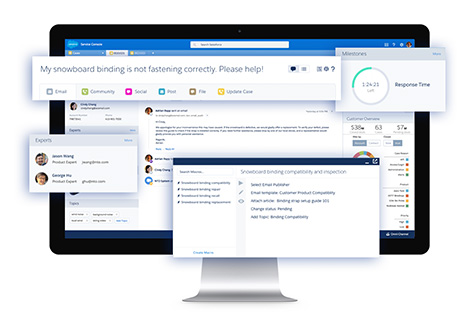sales operations
4 Ways to Simplify Your Sales Operations

1. Improve Your Timing
It’s been said that the early bird gets the worm, but the unspoken reality is that the early bird only gets the worm when the worm is early as well. What does that mean for business? Well, it means that when it comes to sales operations, the best time to act is whenever the lead is ready. Of course, leads may not let you know when they’re ready to commit, so that means being willing to do the necessary follow up.


2. Simplify Your Sales Process, and Stick With it
Your organisation may have started out with a clear and simple sales process, but over time well-intentioned individuals may start doing things their own way, in order to stand out from their peers. As a result, the process itself may become polluted and inefficient. This can be particularly problematic for sales organisations that use in-house competition between employees as a motivator. Unauthorised deviations from the sales process can lead to a number of problems, such as ineffective B2C and B2B lead generation and follow-up, failure to effectively track and respond to customers in the sales funnel, lower customer retention rates, and last but not least, lost sales.
A recent survey conducted by Vantage Point Performance and the Sales Management Association illustrates how a clear sales process helps companies generate more revenue. In the survey, executives of B2B companies were asked to rate their company’s effectiveness in managing the sales pipeline. Those companies that categorised their pipeline management as ineffective were found to have an average annual growth rate of 4.6%. In contrast, companies that rated their pipeline management as effective had an average growth rate of 5.3%. In addition, companies that said that they had mastered three specific pipeline practices experienced 28% higher revenue growth.
If your company is stuck in a revenue rut, you need to get back to a simple, well-defined sales process. Establish an effective means of implementing the process and following up to make sure that all managers and employees understand and stick with it.
3. Simplify Your Internal Communications Processes
It’s critical to simplify and standardize your internal communications processes, to ensure that all within your sales organisation are connected and aligned with the sales process. That they remain up to speed with changing corporate goals and objectives, and are inspired and motivated to help meet those objectives. In fact, recent research by McKinsey Global Institute found that productivity improves by 20–25% in organisations with connected employees.
A foundational component of effective internal communication is consistent messaging. This means using messaging that your entire sales force is familiar with, and delivering that messaging through the specific channels that they use.
Understanding and utilising preferred platforms, such as texting or social media, is an important part of making sure that the message is received and understood by all. In fact, alternative message platforms may be more commonly used by employees to communicate than emails—which have been shown to bog down employee inboxes.
When holding live sales meetings or seminars, the wording and tone of the messages and missions used during the presentation should reflect the messages the company uses every day. Consistent messaging helps define goals, and ensures that everyone is on the same page in working to meet those goals. In addition, the consistent delivery of inspirational messages in line with the corporate mission statement can motivate employees to think bigger and go the extra mile to deliver a better customer experience through every stage of the sales funnel.
Additionally, be transparent in your communication. Allow employees to ask questions of management and share their ideas and insights, as this is a simple-yet-potent component of an effective internal communication process.
4. Keep High-Level and Low-Level Items Separate
Even the most efficient sales force can get bogged down when work starts getting overly complicated with small details. Streamline the situation by keeping high-level plans and goals separate from low-level items. It’s not uncommon for marketing plans to go into minute detail regarding how each step of the plan should be executed. However, employees only have so many hours available in a day, and too much detail can actually prevent progress. A better approach is to first create a precise, high-priority plan focused on overall goals, then to segment that plan into smaller sub-plans that get into all the little details without detracting from the broader high-level plans.
5. Invest in Cloud-Based, CRM Technology
Your traditional Customer Relations Management (CRM) system may appear to be doing all you need it to do for your sales team, but what about the rest of the organisation? Wouldn’t it be beneficial for other departments such as marketing and customer support to have quick and ready access to key CRM data? The answer to that question is yes, and that’s where a cloud-based CRM solution comes into play.
Cloud technology takes CRM to a whole new level in a number of ways. First and foremost, storing CRM data in the cloud makes that data readily accessible, anywhere, and at anytime, to key people in all departments of the organisation. Sales personnel can get fast, frequent and exact information from the cloud with regard to customer activities and behaviours within the sales funnel. Then they can act on this customer-relevant information by contacting customers and prospects even while on the go. As a result, the sales force becomes more streamlined and productive, while other key departments stay informed and updated through every step of the customer journey.
As for simplicity, many of today’s cloud-based CRM solutions are affordable and very easy to implement, as they come equipped with everything your organisation needs to become more successful and profitable right out of the box.
By simplifying your sales process, improving internal communications, separating high-level items from low-level ones, and investing in high-quality, cloud-based CRM, your organisation will be able to produce sales operations that are clear, effective, and to the point. And that means that you’ll be on your way to creating a more efficient, productive, and profitable sales organisation.



